The Saga of Ira Watson and Nellie Ormsby
Ira C. Watson was the seventh of Nehemiah and Mary Ellen (Lewis) Watson’s twelve children.
Ira was born August 13, 1873 in Connecticut, likely in Voluntown.* His family moved from Rhode Island to Connecticut when he was young. Most of his childhood years in Connecticut probably were spent in Thompson, in the village of North Grosvenor Dale. Ira’s name appears in a city directory for New London, Connecticut, as early as 1892, when he was noted as “boarding” at 45 Willetts Avenue in New London, the same address listed as the home of his father. According to this directory, both Nehemiah and Ira were employees of the Brown Cotton Gin Company.
“Brown Cotton Gin Company” sounds like a place that mills cotton, but in fact it was a shop that made machine parts for cotton gins. Nehemiah and Ira worked as machinists there. Eventually Brown Cotton Gin evolved into the Babcock Printing Press Company, switching from making cotton gin machinery to manufacturing printing press components.
On June 10, 1896, in New London, Ira Watson married Nellie Ormsby. (This date of marriage, obtained as a transcribed record from Findmypast.com, is different from the date mentioned in a newspaper article, shown below, regarding Nellie’s desire for a divorce from Ira.) Nellie was born on April 8, 1878, likely in Waterford, CT, the daughter of (Curtis John?) Ormsby and his wife Sarah Hepzibeth Lay.
Per the 1900 census, Ira and Nellie Watson lived at 80 Willetts Avenue in New London. Ira and Nellie had four children, three of whom survived to adulthood:
- Ira Curtis, born July 11, 1897, died March 11, 1898.
- Gertrude Nellie, born December 1898, died March 2, 1983.
- Charles Lloyd, born August 8, 1902, died April 25, 1981. Lloyd married Irene B. Smith.
- Ethel May, born March 24, 1906, died July 1968. Ethel married (1st) Charles Edward O’Loughlin, Sr. (1896-1951); married (2nd) Martin Noonan (1885-1981)
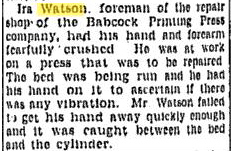
We would know relatively little about Ira and his family if all we had were vital records and census pages. Thanks to the (now mostly defunct) online Google News Archive Search, we were able to dig up some articles mentioning Ira Watson in the New London, Connecticut, newspaper The Day. In the August 27, 1927 edition, in a column titled “New London 25 Years Ago,” is an item about Ira being injured at work on that same date in 1902:
“Ira Watson, foreman of the repair shop of the Babcock Printing Press company, had his hand and forearm fearfully crushed. He was at work on a press that was to be repaired. The bed was being run and he had his hand on it to ascertain if there was any vibration. Mr. Watson failed to get his hand away quickly enough and it was caught between the bed and the cylinder.”
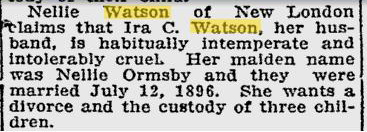
This accident occurred just weeks after the birth of Ira’s son Charles.
Some years later, Ira and Nellie show up on page 7 of The Day on March 2, 1909: “Nellie Watson of New London claims that Ira C. Watson, her husband, is habitually intemperate and intolerably cruel. Her maiden name was Nellie Ormsby and they were married July 12, 1896. She wants a divorce and the custody of three children.”
We don’t find Ira, Nellie, or their son Lloyd in the 1910 census. Nellie G. Watson, age 11, and Ethel M. Watson, age 4, show up in the village of West Mystic in Groton, Connecticut. They were living in the household of Ira’s sister Ardelia Rawson and her husband Frank. Nehemiah, now a widower, lived there, too. The girls, listed as nieces, clearly are Ira’s and Nellie’s two daughters.
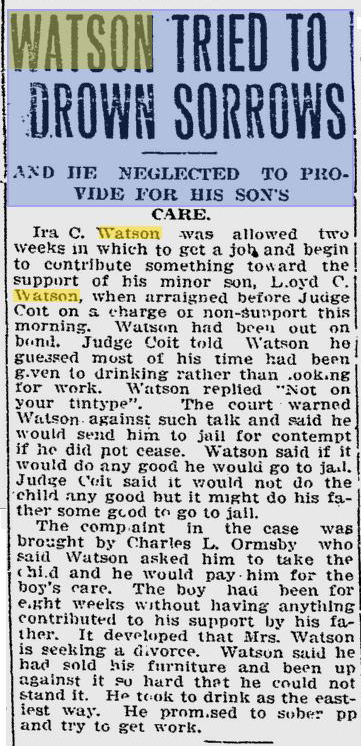
Ira is mentioned in the newspaper four times in 1911.
Page 2 of The Day’s April 3rd edition devoted a sizeable chunk of column to Ira’s troubles. The caption: “WATSON TRIED TO DROWN SORROWS AND HE NEGLECTED TO PROVIDE FOR HIS SON’S CARE.”
“Ira C. Watson was allowed two weeks in which to get a job and begin to contribute something toward the support of his minor son, Lloyd C. Watson, when arraigned before Judge Coit on a charge of non-support this morning. Watson had been out on bond. Judge Coit told Watson he guessed most of his time had been given to drinking rather than looking for work. Watson replied, ‘Not on your tintype.’ The court warned Watson against such talk and said he would send him to jail for contempt if he did not cease. Watson said if it would do any good he would go to jail. Judge Coit said it would not do the child any good but it might do his father some good to go to jail.”
“The complaint in the case was brought by Charles L. Ormsby who said Watson asked him to take the child and he would pay him for the boy’s care. The boy had been for eight weeks without having anything contributed to his support by his father. It developed that Mrs. Watson is seeking a divorce. Watson said he had sold his furniture and been up against it so hard that he could not stand it. He took to drink as the easiest way. He promised to sober up and try to get work.”
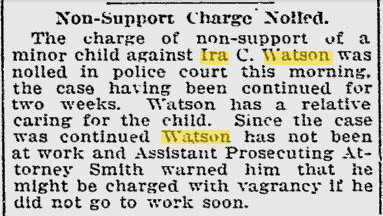
Charles L. Ormsby was Nellie Watson’s older brother.
The next item in The Day came on April 17th. “Non-Support Charge Nolled – The charge of non-support of a minor child against Ira C. Watson was nolled [i.e., dismissed] in police court this morning, the case having been continued for two weeks. Watson has a relative caring for the child. Since the case was continued Watson has not been at work and Assistant Prosecuting Attorney Smith warned him that he might be charged with vagrancy if he did not go to work soon.”
On July 26, 1911, The Day published an item about Ira and his two younger brothers Everett and Walter.
“FOR THEFT OF BEER — WALTER WATSON JAILED; HIS BROTHERS DISCHARGED.”
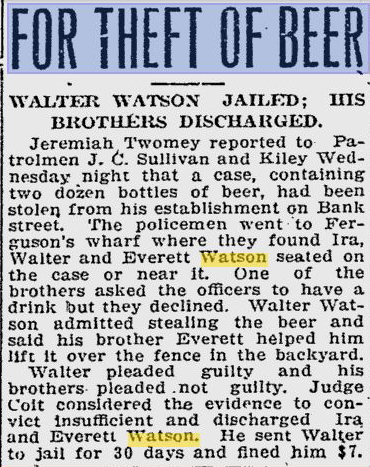
“Jeremiah Twomey reported to Patrolmen J. C. Sullivan and Kiley Wednesday night that a case, containing two dozen bottles of beer, had been stolen from his establishment on Bank street. The policemen went to Ferguson’s wharf where they found Ira, Walter and Everett Watson seated on the case or near it. One of the brothers asked the officers to have a drink but they declined. Walter Watson admitted stealing the beer and said his brother Everett helped him lift it over the fence in the backyard.”
“Walter pleaded guilty and his brothers pleaded not guilty. Judge Coit considered the evidence to convict insufficient and discharged Ira and Everett Watson. He sent Walter to jail for 30 days and fined him $7.”
Ira and Nellie’s divorce became final on Friday, November 10, 1911. An item in the Norwich Bulletin on the following Monday detailed the situation:

“SECURED HER CHILDREN —
Youngest Did Not Know the Mother After Two Years’ Absence”
“Mrs. Nellie Watson of New London, whose decree of divorce was signed by Judge Reed of the superior court on Friday, made claim Saturday for the custody of three children which their father, Ira C. Watson, had in his keeping.”
“Mrs. Watson applied to Prosecuting Attorney Cornin for assistance in securing her children, which the decree gave her. That official detailed Patrolman T. T. Sullivan, instructing him to see that the mandate of the civil court was carried out. The children, 13, 9 and 6 years of age, were taken by Mrs. Watson from a boarding house in Evergreen avenue, New London. The youngest child did not know her mother, not having seen her in two years.”
Nellie not only filed for divorce from Ira in 1909; she left him with the children. Leaving the kids with their father may not have been her first choice, given how few options were available to women back then. This explains Nellie’s apparent absence from the New London census for 1910, as well as why the children were farmed out to relatives.
We notice that the children’s ages were not reported entirely accurately in this newspaper item. Ethel, the youngest who “did not know her mother,” was only five‐and‐a‐half years old by that time, a fact that better illustrates just how young she was (not quite three) when her mother originally filed for divorce.
After his marriage to Nellie failed, Ira was listed in New London city directories only sporadically, in various places of residence, his occupation given sometimes as machinist, other times as inspector at BPP Manufacturing – which almost certainly was the Babcock Printing Press company.
Ira’s continued problems with alcohol were worth some lines of print in the July 17, 1917 edition of The Day.
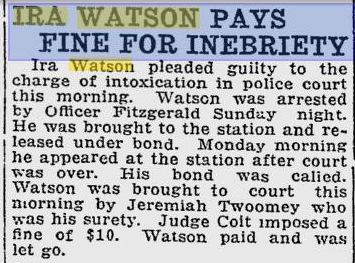
“IRA WATSON PAYS FINE FOR INEBRIETY – Ira Watson pleaded guilty to the charge of intoxication in police court this morning. Watson was arrested by Officer Fitzgerald Sunday night. He was brought to the station and released under bond. Monday morning he appeared at the station after court was over. His bond was called. Watson was brought to court this morning by Jeremiah Twoomey [sic] who was his surety. Judge Coit imposed a fine of $10. Watson paid and was let go.”
Jeremiah Twomey was well acquainted with Ira Watson. Mr. Twomey appears in the 1920 census for New London as a 60-year-old Irish immigrant whose occupation was proprietor of a “cafe.” A map of the city of New London, dated 1911, includes a business listing for Jeremiah Twomey, Wholesale Liquor Dealer, located at 52 Bank Street. Ira’s World War I draft registration, dated September 12, 1918, lists Jeremiah Twomey as his employer and 52 Bank Street as his “permanent home address.” For his occupation, Ira wrote “machinist” and then added “teamster” above that. He listed his father as his nearest relative.
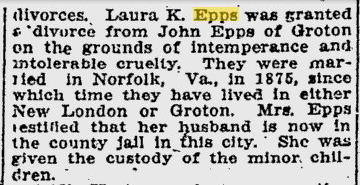
Ira C. Watson got married again. On September 22, 1919, in Portland, Connecticut, he wed Laura Katherine “Kate” Epps (whose maiden name was either Littlefield or Satterfield). Kate divorced her first husband, John Epps, as described in an item in the January 23, 1914 issue of The Day. Ironically, Kate’s grounds for divorce were the same as Nellie’s: John had a drinking problem.
We doubt that Kate married John Epps in 1875, as that newspaper item asserts. Her age, as given in various censuses, is all over the map, too. In 1900 Kate Epps was 38 years old (born October 1861); in 1910 she was 52 years old, apparently having aged fourteen years in the intervening decade. By 1920 she was down to 49 years of age. We haven’t found Kate in any earlier census. Perhaps her date of birth as given in her obituary is true: October 23, 1866. If that date is correct, Kate was about seven years older than Ira Watson.
Ira and Kate appear in the 1920 census as residents of Portland, CT. The household included Kate’s sons Frank A. Epps, age 16, and Paul E. Epps, age 13. Ira was employed as a laborer at a tobacco farm. By spring of 1923, Kate and Ira were living apart (see “Ira Stalked His Estranged Second Wife” in The Watson Family’s Greatest Hits). We doubt they ever got back together again.
Laura Katherine (Littlefield/Satterfield) (Epps) Watson died on March 5, 1929, in Hartford, CT, at the home of her daughter Irene Ellen (Epps) Geer. Her obituary, published in The Day (March 7, 1929, pg. 12), named her as “Mrs. Laura Watson ... wife of Ira Watson.” Kate (Epps) Watson was laid to rest in Jordan Cemetery, Waterford, CT.
While we don’t find Ira in the 1930 census, we find his residence listed as 30 Howard Street in the 1931 New London city directory. By 1940, Ira was boarding in the household of Nellie Farnan at 54 Mountain Ave. in New London. That census noted that he resided at the same address in 1935.
When Ira died on November 2, 1943, he was still boarding with Nellie Farnan in New London, now at 36 Shapley Street. At 10:57 p.m., Nellie observed Ira lying on his back on the porch and summoned the police, telling them she was “unable to rouse him.” Two policemen came to the house and determined that Ira was dead (The Day, New London, CT; Wed., Nov. 3, 1943, pg. 11). Cause of death was acute cardiac dilatation. Ira was 70 years old.
The informant for the death record was his sister, Hattie Tourjee. She gave Ira’s marital status as divorced, from Nellie – no mention of a second wife. She provided Ira’s correct date of birth but gave his birth place as North Grosvenor Dale, CT (wrong) and their father’s place of birth as Voluntown, CT (wrong again). Hattie also said their mother’s birth place was Beach Pond, RI – a nice touch, given that it specifies a locale in the town of Exeter, RI, where Mary Ellen (Lewis) Watson was born. (We’re confident Hattie got that right.)
On November 5, 1943, Ira was buried in the rear left corner of Lot #390, Avenue I, in Jordan Cemetery, Waterford, CT – his father’s twelve-grave lot.
So whatever became of Nellie and her three children with Ira? We assumed she remarried and changed her name, perhaps giving her children the surname of their stepfather. The 1920 and 1930 censuses don’t reveal their whereabouts under the name Watson. For a long time, Nellie’s half of this story dead-ended with the messy divorce items in the newspaper.
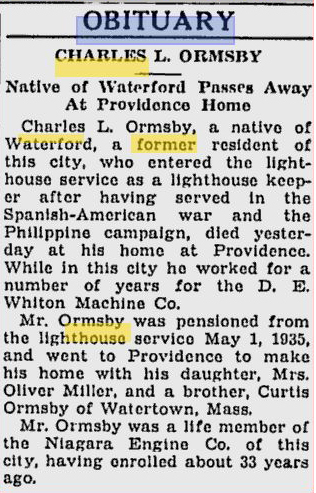
Charles L. Ormsby turned out to be the link to finding Nellie and the kids. We’d found him in the 1930 census, living alone as a lighthouse keeper. (Charles was keeper for the Plum Beach lighthouse near North Kingstown, RI.) When Charles died on July 30, 1936, The Day ran his death notice the next day. We pursued the several good clues embedded in this obituary but found no Mrs. Oliver Miller in Providence, Rhode Island, at least not in the 1930 census. But in 1920 there was a woman named Olive Miller, wife of Theodore A. Miller, living in Providence. Besides a baby son, she had three older children named Gertrude N., Lloyd C., and Ethel M. Wilson.
Olive Miller wasn’t Charles Ormsby’s daughter; she was his sister, Nellie, the former Mrs. Ira C. Watson. The data in the 1920 census were a match for Ira Watson’s ex-wife and children.
We put together the pieces of this puzzle using Charles Ormsby’s World War I draft registration and an entry in Ancestry.com’s World Tree Project that is no longer available. The anonymous author of this particular family tree included notes saying that Olive Nellie Ormsby’s first husband, and the father of her three older children, was “C. H. Wilson” (which we know to be incorrect). She had two children (Ted and Frances) with her second husband, Theodore, before he died in 1928.
Charles Ormsby’s WWI draft registration gave the name of his nearest relative as his sister, Mrs. Olive Miller of 66 Beaufort Street in Providence, RI. This means that Nellie had remarried by September 12, 1918, the date on Charles’s draft registration. (The census shows Olive living at this same address.) Update: The 1915 Rhode Island state census shows Olive already married to Theodore Miller and living in Providence.
The family tree made references to “Aunt Olive” and “Uncle Charles” Ormsby. The dates given for Lloyd were incorrect, but there was enough family lore in the notes to identify these people. On the page about Charles L. Ormsby, we learned that he was “mustered into Army at Niantic, Conn. July 3, 1898, Company D, Third Connecticut Infantry, in [the] Spanish[-American] War. At this time he was living in New London, Ct. with guardian, Mrs. Ira Watson.”
On the page about Lloyd, we learned that he was an M.D., an army general, and “head of the Selective Service.” Notes include the comment that he was “buried with Uncle-Charles Lay Ormsby under [the] name Pachey.” The data we found at Frank Pachey’s Findagrave memorial tell us that Frank Pachey was Olive Nellie Ormsby’s maternal uncle, the man who married Emma Frances Lay.
Lloyd was indeed a physician, and his name shows up in a few things on the Internet indicating that he was involved with the Selective Service in Providence, RI. Lloyd married Irene B. Smith, with whom he had three children: a daughter who is still alive as of this writing; and sons Robert and Curtis. Lloyd enjoyed a long and distinguished career – retiring at the rank of brigadier general – and died on April 25, 1981, as Lloyd Charles Wilson. He is buried in Quidnessett Memorial Cemetery in No. Kingstown, RI. Lloyd's Find A Grave memorial can be found at this link.
Olive Nellie Miller passed away in March of 1963, thirty-five years after the death of her second husband Theodore Miller and twenty years after Ira’s passing. She is buried in Jordan Cemetery, Waterford, CT, with Theodore.
Did Nellie actually marry someone named Wilson before she married Theodore Miller? It’s possible; but we think not. Wilson is just a tweaked form of Watson. Changing the A to I and un-crossing the T altered that surname just enough that Ira would have a hard time finding his ex‐wife and children. It also preserved the essential structure of the surname Ira’s kids were old enough to know was theirs. That Lloyd, Ira’s only son, chose to keep this altered surname throughout his life suggests the connection with his biological father remained permanently broken.
If Lloyd’s lineal male descendants ever participate in a Wilson surname DNA project, they will hit a brick wall on the Y chromosome analysis, indicative of a “non‐paternity event.” That event was the unfortunate saga of Ira and Nellie.
POSTSCRIPT: We have learned some interesting family lore from a descendant of Lloyd Wilson (born Charles Lloyd Watson in 1902). Apparently Lloyd was just a child when his mother, Olive Nellie, told him that his father had died. We know that Ira Watson was very much alive until early November 1943.
ADDENDUM: We finally managed to locate Nellie in the 1910 census. She was already living in Providence, RI, and she was using the name Olive Wilson. So now we know that the switch from Watson to Wilson predated Nellie’s divorce from Ira, which wasn’t final until November of 1911.
In 1910, Olive Wilson was a lodger in the household of Annie M. Whitcomb at 494 Pine Street in Providence. Interestingly, one of the other lodgers in this house was a 37‐year‐old bank teller named Walter H. Watson. Likely he was Walter Hazard Watson, son of Walter Scott Watson and his wife Sarah Fales Potter – and a distant cousin of Ira Watson (though Walter and Ira wouldn’t have known each other). Little wonder that Nellie adopted a similar‐but‐different surname. Rhode Island was thick with Watsons.
Olive worked as a “jeweler” in a jewelry factory. She was one of countless people employed in the jewelry‐making industry in Providence that dated clear back to 1794.
We know that Olive married Theodore A. Miller. Theodore André Miller was born on March 15, 1873, in Boston, Massachusetts, the son of Lucy Callahan (widow or ex‐wife of Leander Porlier) and French immigrant Theodore T. Miller.
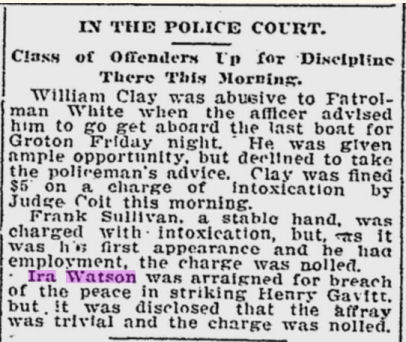
In 1910, Theodore was residing at 10 East Transit Street in Providence, RI, with his father, stepmother, and an assortment of siblings. At 37 years of age, Theodore was single and working as a pressman at a “printing office.” The Millers lived on the east side of the Providence River, two or three miles away from where Olive lived.
Theodore’s sister Mary H. Miller worked as a “stamper” in the jewelry business. Perhaps Mary introduced Olive to Theodore.
We don’t blame Olive Nellie Ormsby for divorcing Ira Watson. It’s clear that he had a drinking problem, and he may have been physically abusive.
On August 24, 1912, an item on page 6 of the New London, CT, newspaper The Day mentioned that Ira Watson had made an appearance in police court: “Ira Watson was arraigned for breach of the peace in striking Henry Gavitt but it was disclosed that the affray was trivial and the charge was nolled.”
Henry Gavitt was the husband of Ira’s sister “Georgie” (Georgia Anna Watson). The newspaper item tells us that the incident was serious enough for the police to be involved. That the case got dismissed as “trivial” sounds like someone downplayed what happened. We cannot help but feel that if Ira felt free to take a swing at his brother‐in‐law, he may well have hit his wife and children, too.
*UPDATE, 8 August 2023
We changed our wording in this article about Ira C. Watson’s place of birth, from Rhode Island to Connecticut, after reviewing his data from two particular sources.
In the 1875 Rhode Island state census, Ira’s place of birth was given as Connecticut. The other Watson children’s various birth places check out, which lends credibility to Ira’s data. This is in contrast to later census years when Ira’s birth place was listed as RI. Federal censuses can be somewhat unreliable for reasons involving who provided the info.
The New London, CT, record of the birth of Ira and Nellie’s son Charles Lloyd in 1902 notes the father’s place of birth as Voluntown, CT. Originally we’d dismissed this as probably wrong, especially if Ira’s wife Nellie had provided the info. Now we think it’s likely to be correct, even though Nehemiah Watson and family were Rhode Island residents when Ira was born.
Mary Ellen Watson’s parents, Caleb and Catherine Lewis, were enumerated in Voluntown, CT, in both 1870 and 1880. It’s reasonable to think that Mary Ellen took her kids to visit their grandparents in August 1873, timing it to coincide with her due date and lying‐in period.
Fun Factoid
The New London, CT, birth record of Ira and Nellie’s daughter Ethel May spelled out the father’s name in full. We were so baffled by Ira’s middle name on that record, we consulted one of the staff people at the New London City Hall. He agreed with us that it looked exactly like Callop. That is not a name we recognize from anywhere.
Our only idea is this: Ira’s father Nehemiah spent a portion of his childhood with his paternal grandmother, Annie (Gallop) Watson. Perhaps he wished to honor her memory by giving Ira her maiden name as his middle name.
Callop is not Gallop, of course. But we happen to know that Nehemiah wasn’t the best speller. Nehemiah Watson wrote in pencil, “Maid [sic] By Nehemiah Watson / Feb 10th 1879 / Hope Valley” on the inside of the back of a violin he crafted. We saw this with our own eyes at the Yale University Collection of Musical Instruments in New Haven, CT, on October 10, 2005.**
There is no doubt that Ira’s middle initial was C. But maybe it should have been G.
**To see a photo of the abovementioned violin, visit the section on Nehemiah’s Violin‐Making in Part Three of our series “The WATSON Family of West Greenwich, Rhode Island.”
© 2011‐2023 Elaine Schenot